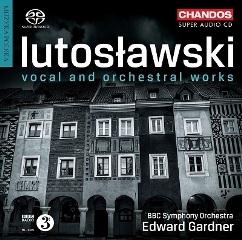Lutoslawski - Vocal & Orchestral Works (2018) CD4
Lutoslawski - Vocal & Orchestral Works (2018) CD4

Mala suita (1950) 10:13 (Little Suite) for Symphony Orchestra 1.I Fujarka (Fife). Allegretto - Poco meno - Poco lento 2:43 2.II Hurra polka (Hurrah Polka). Vivace 1:33 3.III Piosenka (Song). Andante molto sostenuto 2:50 4.IV Taniec (Dance). Allegro molto - Poco più largo - Tempo I - Presto 3:07 Concerto for Cello and Orchestra (1969-70) 23:53 To Mstislav Rostropovich 5.Introduction - 4:14 6.Episodes - 7:34 7.Cantilena - 6:27 8.Finale 5:36 9.Grave (1982) 5:36 Metamorphoses for Cello and String Orchestra Orchestration by the composer of version for Cello and Piano (1981) Stafen Jarocinski in memoriam crotchet=c. 152 - Lento (minim=c. 40) Symphony No. 2 (1965-67) 29:51 10.1 Hésitant - 14:30 11.2 Direct 15:19 Paul Watkins - cello BBC Symphony Orchestra Edward Gardner - conductor
The Little Suite ( Mala Suita ) of 1950 predates his popular Concerto for Orchestra by four years and is full of subtle touches of orchestration that prefigure that early masterpiece. Each of its four movements uses Polish folk tunes (following the proscribed Communist government line), but Lutoslawski’s skill and light touch in the handling of this fairly simple thematic material gives the work freshness and integrity. Gardner and his BBC forces play it with effortless virtuosity and evident enjoyment.
By the time of his Second Symphony (1965-67), the composer’s harmonic thinking had become more complex and he had embraced modernism in the form of a limited aleatory technique, which he referred to as “controlled chance”: passages in which the musicians are given thematic phrases to repeat, independent of their neighbors, for a specifically indicated duration. These free sections alternate with regular metered sections. Many of Lutoslawski’s compositions from the 1960s onward use this aleatory technique to some degree but it is especially notable in this symphony, his first large-scale work to feature it. The symphony is also the first of several pieces where the main thrust of the musical argument occurs in the latter half—literally, as there are two movements ( Hésitant and Direct ). Nevertheless, the work is by no means a complete break from the past. It conceivably might have been titled Concerto for Orchestra No. 2: It spotlights groupings of solo instruments such as oboes, bassoons, and English horn in the first movement and string sections in the second, and is as much an orchestral showpiece as the earlier concerto. Perhaps because of the aleatory sections, early parts of the symphony seem fragmentary—even random—and it lacks the lyrical impulse that the composer brought into the mix for his highly regarded Third Symphony, but ultimately it all comes together in the second movement with some impressive climactic passages.
Obviously no two performances of the Second Symphony sound exactly the same. In his recording from 1977 with the Polish Radio National Symphony Orchestra, the composer finds mystery in the sectional first movement and builds the tension with compelling intensity in the second. His Polish musicians play with commitment but are somewhat distantly recorded. (Full disclosure: I used a 40-year-old LP of this performance for comparison. It may sound clearer on CD.) Salonen’s 1994 Los Angeles recording frames the instruments in a closer perspective and is brisker in its timing. More in the concerto for orchestra mold, it is brilliantly played but rather disengaged. Gardner gets the best of both worlds: involvement and understanding from his orchestra and warm, clear, revealing sound. I do not have Antoni Wit’s Naxos recording at hand but James H. North dismissed it in these pages, saying the “too-smooth performance” glossed over many details.
Lutoslawski’s Cello Concerto (1970) is now regarded as a masterpiece of its genre and has been performed and recorded often. When the reiterated Ds of the cello at the opening are suddenly challenged by the orchestral trumpets, it is clear this will be an essay of confrontation between opposing forces. With his strength of attack and depth of tone, the dedicatee, Mstislav Rostropovich, could take on a full orchestra with aplomb, which he did in his iconic 1974 recording with the Paris Orchestra conducted by the composer. Although Lutoslawski played down the idea, it was thought at the time that the concerto illustrated Rostropovich’s personal confrontations with the Soviet regime. Since then, other cellists have found their own emotional resonances in the music, notably Pieter Wispelwey, whose recording was highly praised by Bernard Jacobson in Fanfare 21:1. Jacobson described the Dutch cellist’s approach as instinctive and mercurial in “a work that depends more than most on the conviction of its performers.” Paul Watkins, without being the larger-than-life protagonist Rostropovich was, holds his own in this new performance. He is suitably assertive but also brings an elegant detachment to his role, which works very effectively: It reinvents the protagonist as an Everyman rather than a Superman. As well, Watkins is a superb musician technically, and again Gardner and the BBC Symphony Orchestra (always comfortable in contemporary music) are first-class.
Finally, the disc includes a short work from 1981 entitled Grave , a series of variations or “metamorphoses” on a theme from the opening of Debussy’s Pelléas et Mélisande. Originally for cello and piano, the accompaniment was transcribed by the composer for string orchestra in 1982. With several vigorous rhythmic episodes it is a good deal livelier than the opera from which it derives, and displays Lutoslawski’s finely tuned ear for texture and color. Watkins and Gardner give a pointed, detailed performance, outshining the robust one by Rafael Kwiatkowski in Wit’s Naxos recording where the cellist is recorded too closely for my taste.
In summary, this disc is a further triumph in a series that looks like it’s becoming the finest overview yet of the work of one of the late 20th-century’s most significant composers. I should add that this is a Super Audio CD, but I have only heard it in regular stereo. --- FANFARE: Phillip Scott, arkivmusic.com
download (mp3 @320 kbs):








